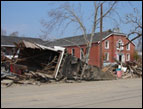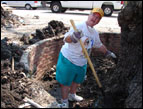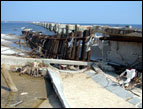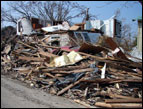|
|
|
| Join CBN.com Contributing Writer Craig von Buseck this week as he journeys into the areas most affected by Hurricane Katrina to provide perspective on its aftermath as well as how God is working in the lives of so many to provide hope. |
| |
|
from the disaster zone
Send People to Help
By
Craig von Buseck
CBN.com Contributing Writer
CBN.com
– BAY ST. LOUIS, Mississippi -- We were headed for ground zero of Hurricane Katrina and I wasn’t sure what lay before me. As we drove along Interstate 10, crossing over from Louisiana into Mississippi, there were countless broken and downed trees, the majority facing the same direction, away from where the hurricane roared ashore only two weeks ago.
We turned off the Interstate and onto the state highway leading toward the Gulf. The scene changed quickly and dramatically. Suddenly evidence of the intensity of the storm was all around us. Large steel buildings were twisted and bent backwards like a gymnast leaning over to do a back flip. Cars and boats were flipped  upside down or on their sides, strewn across the ditches on both sides of the road. A large RV was mangled and facing down into the same ditch. A local car dealership had no windows and the ceiling inside the building was hanging down in scraps of aluminum and electrical wire. upside down or on their sides, strewn across the ditches on both sides of the road. A large RV was mangled and facing down into the same ditch. A local car dealership had no windows and the ceiling inside the building was hanging down in scraps of aluminum and electrical wire.
Coming into the main section of Bay St. Louis, Mississippi, we watched several large army trucks rushing National Guard troops up and down the main street. A giant FEMA sign stood next to the road in a K-Mart parking lot with an arrow pointing toward what appeared to be a large distribution site inside a circus tent. National Guard troops stood directing traffic in and out of the emergency shelter.
All along the main street were businesses without roofs and windows. Piles of debris stood in front of most of the buildings. We followed the signs to Old Town down an increasingly narrowing street. Suddenly we could see glistening water ahead at the end of the street. This inviting sight was contrasted by the damage done to structures all along the road. The closer we got to the bay the more damage and debris we found.
We pulled into the parking lot of the First Baptist Church of Bay St. Louis and noticed that the steeple was missing from the top of the church and was lying on the side of the road. A large spray painted sign hung on the side of the church that read, “We’re Still on the Map”. In front of the church were mounds of debris, including mud-drenched carpeting and chairs that had been removed from the sanctuary. were mounds of debris, including mud-drenched carpeting and chairs that had been removed from the sanctuary.
Several church members were carrying things out of the church and a couple of workers stood in a sunken garden digging out the mud that had been deposited there by the storm surge. One of the workers noticed the CBN.com logo on my shirt and yelled out, “Hey, you’re from CBN? Tell the country that we’re not mad at the president, or the director of FEMA, or the governor of Louisiana, or the mayor of New Orleans. We need the media to stop trying to pin the blame on anyone and start encouraging people to come down here and help us.”
The woman climbed out of the pit and introduced herself as Emily Green, the pastor’s wife. A moment later she introduced me to her husband, Al Green. As we stood among the rubble, he  explained that 95 percent of his congregation was homeless, but they still met the Sunday after the hurricane hit to thank God for His blessings. explained that 95 percent of his congregation was homeless, but they still met the Sunday after the hurricane hit to thank God for His blessings.
“What did you tell them?” I asked.
“I asked the Lord what I should say to my congregation and He told me to go and look at the three crosses standing in the front yard of the church. They are crosses that we use for a Passion play that we hold every Easter. Remarkably, though they aren’t very deep in the ground, somehow all three crosses remained standing. I thought, ‘well the message is that the Lord remains with us through the storm.’”
“But the Lord said, ‘Look closer.’ I examined the three crosses for a moment and realized that the cross on the left was turned away from the other two crosses and the cross on the right was turned toward the other two crosses. The cross in the middle, representing Jesus’ cross, was turned toward the cross that was turned toward His cross – which is unusual because the wind should have moved them all the same direction.”
"That Sunday morning I shared this with the people in my congregation and told them that just like the crosses, each of them had a decision to make concerning their relationship with Christ. In the aftermath of the storm, they could grow bitter and turn away from Jesus, or they could turn toward Him. And just as we could see with the crosses, if we turn toward Jesus, He will turn toward us.”
Emily took me for a walk to the bay front and showed me the unbelievable damage as a result of the 35-foot storm surge and the hurricane force winds. I have never felt so insignificant in the face of nature’s power. The shoreline was completely devastated. The road that ran along the beachfront was completely washed away – only concrete culverts and manhole covers remained standing with exposed sewer lines and water pipes running along the ground. A train trellis ran the  length of the bay, but the tracks had been ripped off the pilings by the storm surge and hurricane force winds. Portions of the train tracks were jutting up out of the water, twisted and mangled like a bread wrapper. length of the bay, but the tracks had been ripped off the pilings by the storm surge and hurricane force winds. Portions of the train tracks were jutting up out of the water, twisted and mangled like a bread wrapper.
Emily pointed to some stilts poking up out of the sand. “Have you ever heard the song ‘Sitting by the Dock of the Bay?’?” I nodded. “One of the singers of that song owned what used to be that restaurant.” She led me down what was left of the street describing how it used to look. Pointing to another slab on the ground she told me, “This was my favorite restaurant, and they had just remodeled. I had dinner there two nights before the storm.” She said it so matter-of-factly, shaking her head as if to say, ‘but it will be back.’ It was clear that the people of First Baptist Church were determined to make this place a home once again.
When we returned to the church, Emily got back down in the sunken garden to continue digging out the clay that had been deposited by the storm surge. The same clay was caked on the ground and inside the church sanctuary. She explained that it was imperative that it be removed as quickly as possible. “This is sediment from the Gulf that was washed ashore and mixed with the waste from the sewers. It is full of contaminants. If we don’t get rid of it, the top layer will harden like concrete, but underneath it will remain moist and full of toxins. If a person’s skin is exposed to this stuff it can give you all kinds of diseases – it could even kill you.”
As she shoveled small, but heavy portions of the dark gray sludge, she wore rubber boots, safety gloves, and a dust mask for protection. Stopping for a moment, Emily explained that at this point in time there was not as much of a need for supplies. “What we need is people to come down here and spend two or three days helping us with this kind of work. This toxic clay has washed into people’s homes. A lot of the elderly people here are having a hard time shoveling it all out. And you have to remove more than just the mud,” she instructed. “You have to take out the drywall six inches above the flood line and then remove all of the insulation behind it to make sure none of the contaminates remain in your house.”
“Please send us people. We need people who are self-sufficient and don’t need to be housed or cared for, who can come down for three days and just help us dig out of this mess.”
I turned and walked into the church to survey the damage. Because the church was built up on a bluff, several feet above the shoreline, it did not sustain the damage that many other residents had, but it was still flooded, and the toxic mud had been deposited on the sanctuary floor six inches deep. They had already removed the carpet and shoveled out most of the mud. They were ripping out the carpet on the altar as I walked in the room. Sunlight filtered through the hole in the ceiling where the steeple used to be.
Pastor Al gave us directions to the home of the friend I met on the flight the day before and we drove over to her neighborhood. On the way, we stopped to survey the damage to the causeway over the bay. The road was completely gone and, and like the train trellis, all that remained were the pilings sticking out of the water.
We drove down the street that led to Beezy’s home – this was the neighborhood that was not protected by the bluff. I can’t describe the absolute destruction. Most of the homes had nothing left  of them other than the foundation. Cars that were left behind were mangled and rolled on their sides or tops. The trees were strewn with debris. I saw a park bench wedged into a tree limb ten feet above the ground. of them other than the foundation. Cars that were left behind were mangled and rolled on their sides or tops. The trees were strewn with debris. I saw a park bench wedged into a tree limb ten feet above the ground.
We arrived at the location where Beezy’s house once stood. The neighbor’s house was a steel structure, and all that remained was the skeleton and a spiral staircase made of iron. And just like Beezy described to me on the airplane from Atlanta, all that I could find of her home were the concrete front steps.
How You Can Help
You can take part in Operation Blessing's ongoing disaster response efforts by making an online donation to help those affected by Hurricane Katrina.
For information on Project Church Welcome, click here or call 1-800-700-Club (2582).
Give to help the Victims of Hurricane Katrina through Operation Blessing
Read Craig's Blog, ChurchWatch, on CBN.com
More from
Craig von Buseck on CBN.com
CBN IS HERE FOR YOU!
Are you seeking answers in life? Are you hurting?
Are you facing a difficult situation?
A caring friend will be there to pray with you in your time of need.
|